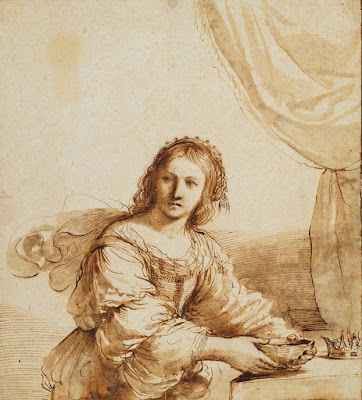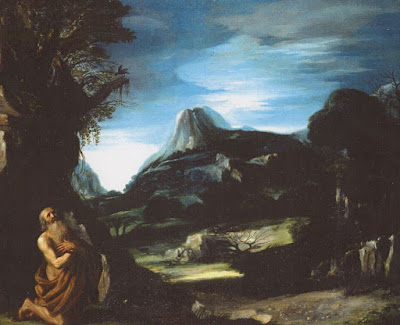 |
| Guercino (Giovanni Francesco Barbieri) Mars as Warrior 1630 oil on canvas Wellington Collection, Apsley House, London |
 |
| Guercino (Giovanni Francesco Barbieri) Venus and Cupid 1630 oil on canvas Wellington Collection, Apsley House, London |
 |
| Guercino (Giovanni Francesco Barbieri) Venus and Cupid 1630 drawing (compositional study) Royal Library, Windsor |
 |
| Guercino (Giovanni Francesco Barbieri) Sophonisba 1630 oil on canvas (trial version) Fondazione Sorgente Group, Rome |
 |
| Guercino (Giovanni Francesco Barbieri) Sophonisba 1630 drawing (compositional study) Royal Library, Windsor |
 |
| Guercino (Giovanni Francesco Barbieri) Sophonisba 1630 oil on canvas (finished version) Fondazione Sorgente Group, Rome |
"The two [versions of Sophonisba] have the same dimensions, suggesting that the contours of the figure were transferred from one canvas to the other. The empty fluted gold cup is much the same in both works, and even Sophonisba's features are similar."
 |
| Guercino (Giovanni Francesco Barbieri) The Crucifixion with Sts Francesca Romana and Elizabeth of Hungary 1630 oil on canvas Potocki Chapel Cathedral of Sts Stanislaus & Wenceslaus Krakow, Poland |
 |
| Guercino (Giovanni Francesco Barbieri) The Crucifixion with Sts Francesca Romana and Elizabeth of Hungary 1630 drawing (compositional study) Royal Library, Windsor |
 |
| Guercino (Giovanni Francesco Barbieri) The Crucifixion with Sts Francesca Romana and Elizabeth of Hungary 1630 drawing (figure study - St Elizabeth) Ashmolean Museum Oxford |
"Among Guercino's commissions for 1630, [Carlo Cesare] Malvasia mentioned an altarpiece of The Crucifixion with Sts Francesca Romana and Elizabeth of Hungary, for 'Sig. Pietro Martire Merlini da Forlì', which the patron intended to place over an altar in the church of the Madonna del Popolo, outside Forlì. The account book records a payment of 300 scudi to the painter on 29 October that same year. As in many representations of the saint from the time, St. Elizabeth of Hungary is shown wearing a crown and is sometimes referred to, as indeed by Malvasia, as Queen Elizabeth of Hungary. Though of noble birth, she was never a queen, only a princess. . . . The altarpiece remained in the church of the Madonna del Popolo until 1808, when the Merlini family, still the titular owners of the chapel, took possession of it rather than following the diktat of the newly established Italian Republic and conceding its transfer to Milan. It seems that Artur and Zofia Potocki bought The Crucifixion and the St Francis in Ecstasy with an Angel [c. 1620] on their second visit to Italy in 1829-30, acting on the advice of a Florentine dealer, Fedele Acciai."
 |
| Guercino (Giovanni Francesco Barbieri) Moses holding the Tables of the Law ca. 1630 oil on canvas private collection |
"No painting of the subject is mentioned in either Malvasia or the account book, but a similar composition is documented in a finished drawing in the Louvre [directly below], in which the half-length Moses turns towards the spectator and points to one of the tables of of the law. The physical type is the same in both works, as, too, is the way soft shafts of light indicated by the smudging of the media represent the prophet's horns. A compositionally related engraving of the same subject [also below] by Pasqualini, dated 1630, also shows the prophet half length, but this time in profile to the right."
 |
| Guercino (Giovanni Francesco Barbieri) Moses holding the Tables of the Law ca. 1630 drawing (compositional study) Musée du Louvre |
 |
| Giovanni Battista Pasqualini after Guercino Moses holding the Tables of the Law 1630 engraving British Museum |
 |
| Guercino (Giovanni Francesco Barbieri) Moses holding the Tables of the Law ca. 1630 oil on canvas Galleria Palatina, Palazzo Pitti, Florence |
 |
| Guercino (Giovanni Francesco Barbieri) Landscape with St Paul the Hermit 1631 oil on canvas private collection |
"[Landscape with St Paul the Hermit] was ordered by the Comunità di Cento as a gift for the Vice Legate of Ferrara, Monsignor Fabio Chigi (1599-1667), the future Pope Alexander VII (reg. 1655-67). Guercino charged them 46 scudi, a stiff price for a picture of only small dimensions, presumably because the landscape details, especially the great tree at left, were as time-consuming as a standard half-length figure. He was paid on 15 October 1631. This appears to be the artist's last independent landscape in which human action is subordinated to natural surroundings."
 |
| Guercino (Giovanni Francesco Barbieri) St Andrea Corsini 1631 oil on canvas Galleria Corsini, Florence |
– quoted texts from The Paintings of Guercino: a revised and expanded catalogue raisonné by Nicholas Turner (Rome: Ugo Bozzi Editore, 2017)